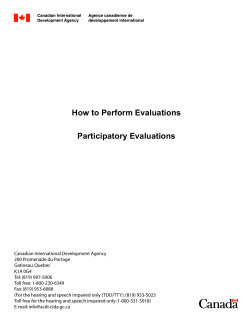
How to evaluate citizens participation
DEMO-net workshop on Evaluation of e-Participation De Cindio and Peraboni 1 How to evaluate citizens participation in the framework of an e-participation project Fiorella de Cindio and Cristian Peraboni University of Milan, Dept. of Informatics and Communication Via Comelico, 39 – 20135 Milano - Italy peraboni@dico.unimi.it, fiorella.decindio@unimi.it In 2003 Italy’s Ministry for Innovation and Technology issued a “Call for selecting projects to promote digital citizenship (e-democracy)” (De Pietro and Tedeschi, 2005). Ten municipalities in the Lombardy Region (Mantua – the coordinator, Brescia, Como, Desenzano sul Garda, Lecco, Pavia, San Donato Milanese, Sesto San Giovanni, Vigevano, and Vimercate), some with previous experience managing community networks, presented a project named “e21 for the development of digital citizenship in Agenda 21” under the scientific coordination of A.I.RE.C., the association for community networking set up in 1996 under a protocol of cooperation between the Lombardy Region and the Department of Informatics and Communication of the University of Milan. All ten have signed the Aalborg chart, i.e, are committed to pursuing the Kyoto Protocol by involving citizens in sustainable development projects and activities. Several had already undertaken the typical local Agenda 21 process that involves the local community, but the use of ICT to manage participation has so far been marginal (e.g., websites with FAQs, some documents and a public forum), and people’s involvement, typically high at the outset, often tends to fall off. The causes of the decreasing participation (“there is no hour in the day convenient for everybody to meet”) could be mitigated by the appropriate use of appropriate ICT applications. The purpose of the project is therefore to overcome the hindrances to participation typical of local Agenda 21 processes -- as described, for instance, by Evans and Theobald (2003) -- by creating a social environment on a custom-designed, dedicated online-deliberation platform. This environment is called Deliberative Community Networks (DCN for short) as it aims at improving the so to say traditional community networks by introducing deliberative tools. DCN have been conceived by considering the steps of a typical local Agenda21 process and the deep analysis of several participatory processes reported in (Bobbio, 2004), and are presented in (De Cindio, De Marco and Ripamonti, 2007). DCN allow citizens, who join together in well-defined topic groups where a particular issue or a specific problem is brought up, to use tools that conceptually belongs to different spaces: • community space: tools to communicate and carry on open-ended discussions which facilitate the rise of mutual trust; • informational space: tools to facilitate information sharing, including facilities for collecting information provided by citizens to support group activities; • deliberative space: tools to foster the creation of a shared vision position among the group members. Deliberation space represents the core of the participatory system. Participatory processes, as shown above, consist of a series of deliberation stages, each relying on DEMO-net workshop on Evaluation of e-Participation De Cindio and Peraboni 2 a different participatory modality and involving different participants. This therefore calls for outright structured participatory processes, divided into clearly distinct phases, each of which relies on a specific deliberation tool. In the framework of the e21 project we have up to now developed the so called city map (see the figure) in the community area, and the following deliberative tools: • Informed discussion is an enriched forum with facilities for sharing documents supporting the discussion and for producing in a collaborative way a document which summarizes the discussion. • Certified citizen consultation to poll participants, who choose among alternatives that have come out in earlier deliberation. • Online deliberation structures debate with formal protocol (still under development). • By monitoring the e21 web sites, we want to: • compare participation not supported by the online environment, as it resulted from the investigation carried out at the beginning of the project (De Cindio, Gemini, Sartori and Sonnante, 2007) with ICT-enriched participation; • evaluate e-participation in itself. As the new programming techniques make indicators such as ‘page views’ meaningless (Williams, 2006), while developing the user interface, we had a specific attention to record user’s actions such as reading/opening a post, posting a comment and so on. We are now considering the early literature which studies the indicators (total visitors, unique visitors, feed subscribers, etc) of the success of a blog (see for instance (Kaushik, 2006) for developing some meaningful participation indicators such as number of discussions; number of posts in each discussion; number of different participants, etc. DEMO-net workshop on Evaluation of e-Participation De Cindio and Peraboni 3 We should be able to present at the workshop the first data/indicators for some of the e21 sites. References Bobbio, L., ed. (2004) A piu' voci - Amministrazioni pubbliche, imprese, associazioni e cittadini nei processi decisionali inclusive, Edizioni Scientifiche Italiane. (in Italian). Available at http://www.cantieripa.it/allegati/A_più_voci.pdf De Cindio, F., De Marco, A. and Ripamonti, L.A. (2007) “Enriching Community Networks by supporting Deliberation,” Proc. of the 3rd International Conference Communities and Technologies, Michigan State University, June 28-30, 2007 (to appear). De Cindio, F, Gemini, G, Sartori, M and Sonnante, L (2007c) “Analisi Agenda21 locale, ICT ed e-participation nei comuni e21”, deliverable di progetto, AIReC, 2007 De Pietro, L. and Tedeschi, M. (2005) “E-democracy: projects for electronic citizenship,” Proc, of the 4th workshop on Digital Cities: The Augmented Public Space within 2nd International Conference on Communities&Technology, Milan. Evans, B. and Theobald, K. (2003) “Policy and Practice LASALA: Evaluating Local Agenda 21 in Europe”, Journal of Environmental Planning and Management, 46(5): 781-794. Kaushik, A. (2006) How To Measure Success of a Blog (120 Days in Numbers). http://www.kaushik.net/avinash/2006/09/how-to-measure-success-of-ablog.html Williams, E. (2006) Pageviews are Obsolete http://www.evhead.com/2006/08/pageviews-are-obsolete.asp
© Copyright 2025





















